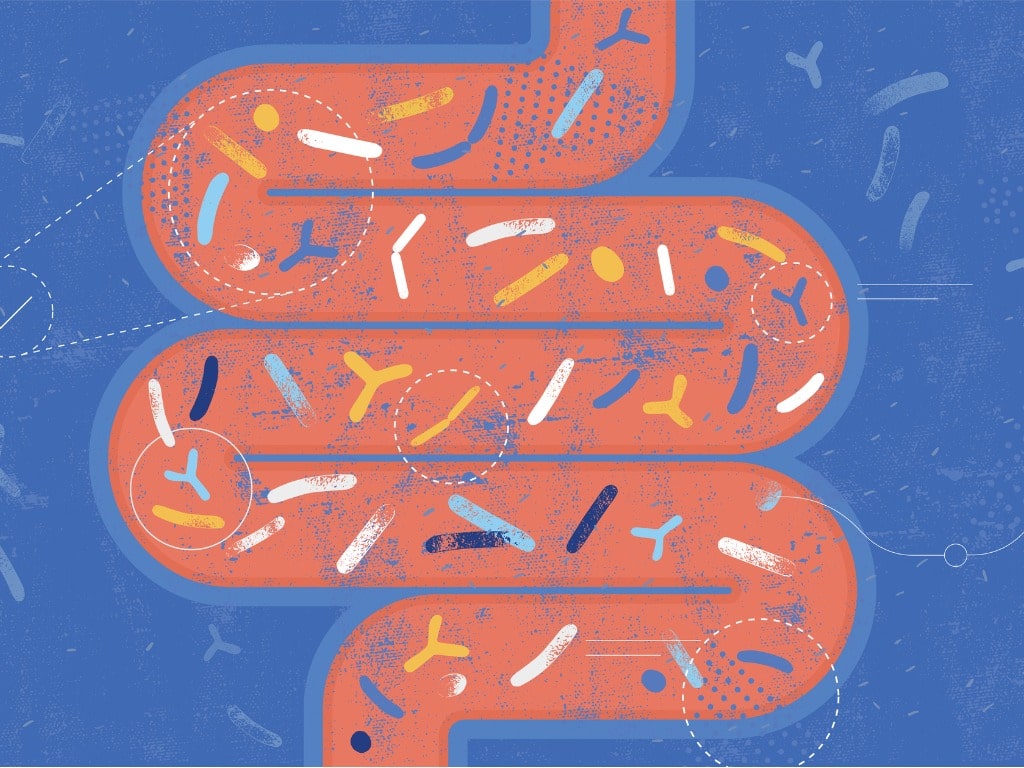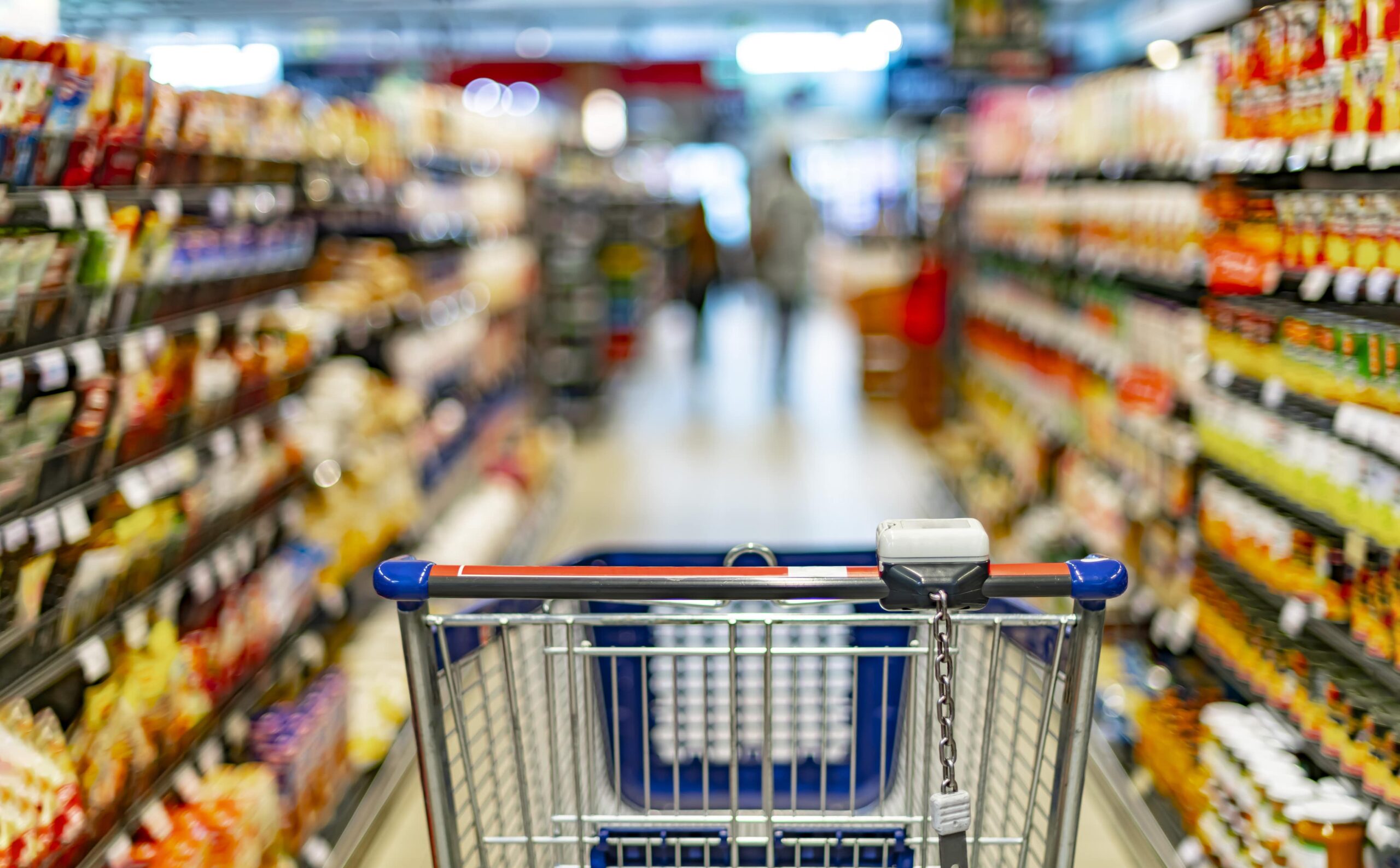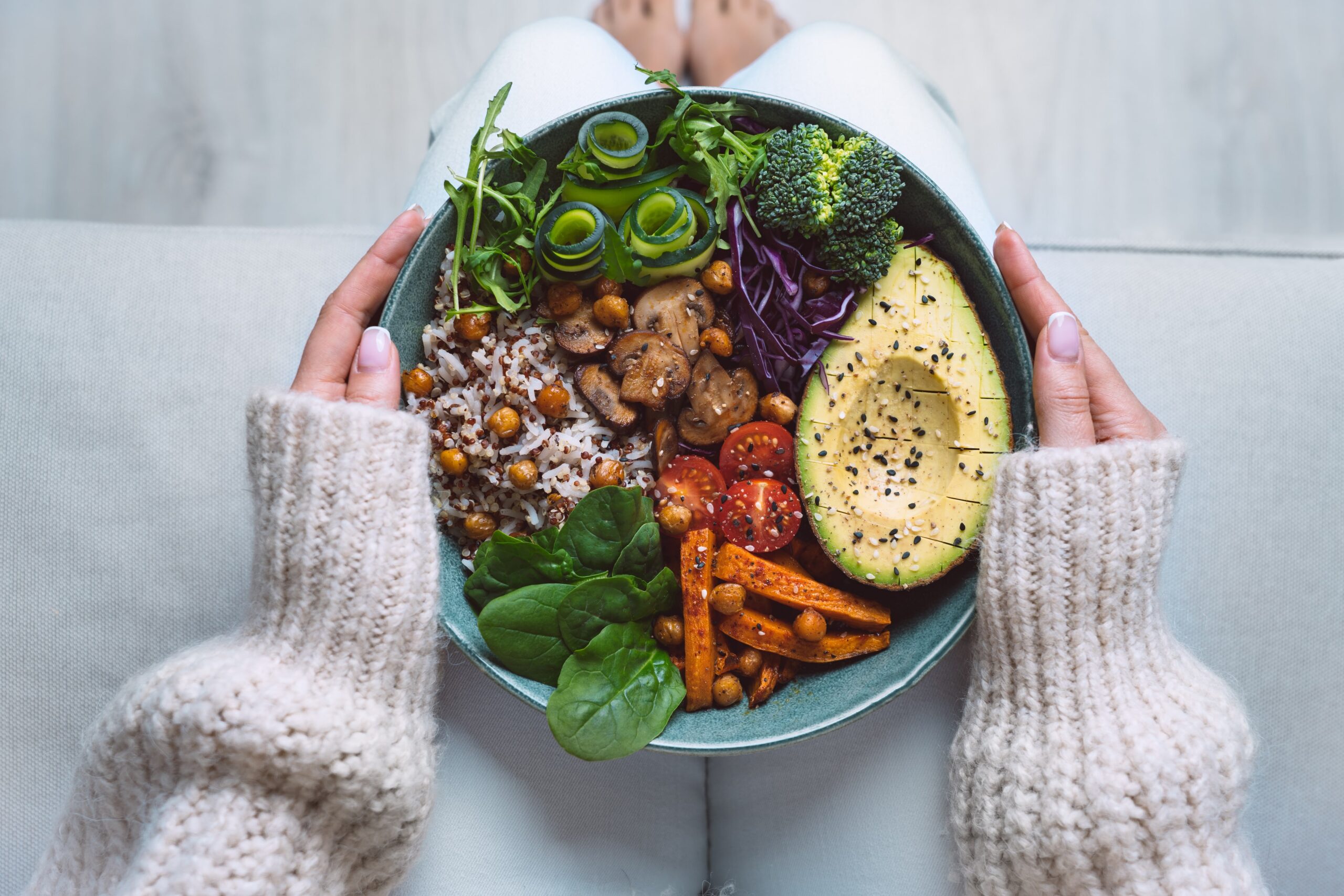Getting digestive waste out of your body is just as important as the good stuff you put in!
We need to have a bowel movement one to two times a day to keep the digestive system working soundly.
Why emphasize a topic that few people want to talk about?
Simply put, the longer that intestinal waste stays in your body, the greater the chances that toxins, wastes, and excess hormones will be reabsorbed and have to be detoxed all over again.
Maintaining regularity minimizes these added exposures (and the metabolic work needed to deal with them!).
Let’s do a quick review of what happens during digestion & set the stage for why problems occur and how specific strategies work to help maintain gut motility.
While I will touch on targeted ways to keep you regular, optimizing any stage of digestion will work in some capacity to restore & maintain healthy motility.
Understanding Motility Issues – a Quick Review of Digestion
Digestion starts with chewing and coating the food with saliva that contains enzymes. It enters the stomach where it is broken down & sterilized by strong acids into a slurry.
This slurry makes its way to the small intestine where the gallbladder & pancreatic juices also aid digestion. Proper acidity & pH promotes the growth of healthy flora & makes the environment less hospitable for pathogenic & opportunistic organisms.
The system can become tired & overworked – leading to insufficient juices being released from the digestive organs – perpetuating the cycle over & over.
When you eat, the body stimulates elimination at the other end of the digestive tract.
If someone overeats & does not give the gastrointestinal system time to work – this stimulated movement is thrown off-kilter.
Those who overeat & snack frequently will also experience a mix of symptoms such as tenderness, bloating, distention, gas, urgency, diarrhea, or constipation. This is partly why we’ll discuss intermittent fasting as a key strategy to helping with motility in the gut.
From the stomach, the food makes its way to the small intestine.
Protective mucosa & numerous folds called microvilli line the small intestine. If the folds were spread out, they would provide an absorbable area the size of a tennis court!
The vast absorptive area is why most nutrient absorption happens in the small intestine – controlled by little gates in the folds called tight junctions.
When the villi are flattened or damaged – OR, the tight junctions are loose due to finalmmation – we call it “leaky gut”.
A leaky gut absorbs proteins, bacteria, and toxins that otherwise would not normally find their way into the bloodstream. The gates can also be “left open” or leaky from inflammation, infection, lack of protective mucosa, or all of the above. This high permeability across the intestine leads to inflammation throughout the body & poor assimilation of nutrients.
When this happens, the gut becomes hypersensitive & diarrhea may occur. When it lasts for a long time, constipation may also develop.
In addition to diarrhea – the immune system can also become irritated & out of balance.
Food sensitivities develop as the immune system becomes extra protective of its damaged intestinal environment. With time, it can lead to alternating constipation or diarrhea & sets the stage for autoimmunity that can affect any tissue in the body.
A muscular gate known as the ileocecal valve separates the small & large intestines. This valve can become sticky or lose its tone due to stress, nutrient deficiencies (ex. Magnesium), inflammation, or bacterial imbalance- leading to motility difficulties.
Once the material makes it through the small intestine, the residual waste & fermentable fibers and starches are now acted upon by the large intestine (colon).
Fibers are broken down further in the colon into smaller byproducts. These metabolites feed bacteria & offer valuable functions across the body.
Reduced presence of these healthy metabolites (prebiotics, antioxidants, natural antimicrobials, immune modulators, short chain fatty acids) is a key pattern of gut dysfunction.
- Low levels of beneficial metabolites affect our metabolism, the presence of other microbes, the health of the gastrointestinal mucosa, and the balance of our immune system.
- Optimizing the presence of colonic bacteria (such as TruBifido), as well as the breakdown of food (Critical Digestion & Enzalase), and supplementing with prebiotic starches when the time is right (MegaPrebiotic, TruFiber, or Biotagen) can be key strategies to optimize this stage of digestion.
- Polyphenols are also increasingly recognized for offering flora-promoting benefits in the gut. I now include MegaMucosa into many protocols as it includes citrus bioflavonoids (polyphenol compounds), immunoglobulins, and key amino acids to support mucosal integrity and flora balance.
- You can also supplement short chain fatty acid supply. While the goal is aways to support GI health with probiotics, prebiotics, polyphenols and anti-inflammatory foods, we will use Enterovite. to support SCFA levels in the short-term.
The colon also helps with electrolyte balance as water is needed to add bulk to the feces & ease elimination. Too much or too little water or electrolytes can cause changes in bowel consistency. If the food sits too long – the body may start reabsorbing some of the waste or putrefying the material into an inflammatory mix.
Sauna therapy does wonders for boosting your stress resilience by boosting Heat Shock Proteins. Interestingly enough, Zinc carnosine doesn’t just help heal the stomach and intestinal lining, it is also a natural way to boost heat shock proteins – on its own or in synergy with sauna therapy.
I’m careful of any electrolyte mixes that contain sugar alcohols as sweeteners as these may disturb gut flora & weight balance – increasing risk of unnecessary bloating.
Diverticulitis is also a buzzword when discussing colon health. Diverticula are little pockets in the wall of the intestine that can sometimes become present or irritated with chronic stress, inflammation, infection & overwork.
Conventional recommendations have been to reduce intake of seeds, nuts, and other foods that may be caught in these out-pouchings – but those recommendations have been refuted in recent years.
I look at these flare-ups as more of an inflammatory response to stress (or loss of parasympathetic “tone” in the intestines), the consumption of inflammatory foods & overall imbalance of gastrointestinal flora. The out-pouchings can be created in the first place by these stresses – and once present, are more vulnerable to these stressors than other parts of the intestine.
The appendix is actually one large out-pouching that may help serve a role as a reservoir or holding tank for bacteria that can be released as the colon needs. The same profile of inflammatory foods, high sugar, low fiber, and everything else that comes with a Standard American Diet – will likely lead to appendicitis. Like diverticulitis, the appendix can become so inflamed that medical attention is necessary.
Removal of the appendix MAY increase your risk of colonic inflammation later in life as you lose that “reserve tank” to maintain flora diversity. I had my appendix removed when my diet was still pretty inflammatory as is the case with most teenagers or college students. More reason for me to carefully maintain the diversity of flora in my gut!
Diverticulitis involves inflammation of smaller out-pouchings further along the colon but is generally easily treated with dietary rest & antibiotics if needed. I’ve written previously on what probiotics to take during and after antibiotics. Note: It’s a good idea to seek professional evaluation to confirm what you’re dealing with and rule out other red flags.
Okay so we’re almost ready for the final event – elimination of waste out of the body.
The colonic wastes are eventually bulked together with the right amount of consistency so that they can be moved through & eliminated. Healthy poop will have the consistency of firm toothpaste. It generally should come out in one or two long pieces. If the poop is too hard, it can be difficult to remove or come out in small, hard pieces – too loose, and you can lose too much electrolytes & water. Loose stools may also cause a sudden urge to go that comes with little warning.
Overstraining during elimination can lead to the development (or aggravation) of hemorrhoids – dilations of blood vessels around the final exit that can bleed during or between bowel movements.
If there is red blood in the stool, this can be due to hemorrhoids or a bleed in the large intestine – seek evaluation as necessary!
If the stool is black and tar-like – it’s a sign of a bleed earlier at the stage of the small intestine or stomach – again, always seek medical guidance if red or tarry stools develop!
If there’s undigested food in the stool, it’s a sign of inadequate digestion via acid at the level of the stomach. You might also experience pencil-thin stools & itchiness around your bottom. These are signs of acid insufficiency (referred to as hypochlorhydria). Betaine HCl is the preferred enzyme for hypochlorhydria – as well as identifying what’s overworking the gut in the first place.
I like Lypo-Optimize by Enzyme Science for enzyme support for fat digestion. If gall bladder issues are known or suspected – Lipo-Gen by Metagenics is well-formulated for digestive & bile salt support. Of course, if you suspect gall bladder issues, seek appropriate evaluation so you can confirm or disconfirm the source of the issue.
Finally, if stool is loose, I think about food reactions (wheat, grains, dairy, etc), low fiber intake, stress, or high/chronic caffeine intake can be a cause.
Most of my clients see me because their scans and scopes came out negative despite still experiencing difficulties with digestion and motility – and others may need to work with a gastroenterologist while giving natural support its due diligence.
Checking your work after a trip to the bathroom tells you a lot on the health of your digestive system!
Support Gut Motility Naturally
I hope you appreciated the review of digestion – and maybe it got some thoughts thinking about what stage your digestion or motility may be compromised. Now, I’m going to detail some more specific strategies for boosting motility in the gut.
Enjoy!
1.) Manage Stress
Physical, chemical, or emotional stress puts the digestive system on alert. The sympathetic nervous system is responsible for running from danger. Relaxation and digestion take a backseat to the concern.
Digestion is controlled mostly by the parasympathetic system. It is this relaxation arm of the nervous system that controls the rhythmic movement of digestive material through the GI tract in a timely manner.
The sympathetic nervous system controls the final elimination of waste. If you have urgency, diarrhea, or green stools – it can be a sign that your sympathetic system is revved up. Green stools are from bile – bile starts green and turns brown by the time waste material reaches the end of the line. If the intestinal contents move too fast, the bile residue does not have a chance to turn brown & your poop will look green.
Stress changes the neurologic tone of your body. A stressed person will likely have 3+ bowel movements per day, loose stools, sudden urgency. As stress or anxiety becomes chronic, or if anxiety turns to depression – constipation is more likely to be experienced as the system becomes tired and sluggish.
Sometimes fixing the motility of the gut comes back to managing your stress and your efforts may be better suited to managing adrenal health – as well as confronting career or relationship issues.
I’ve turned away a number of clients who were better suited to address social and career issues than to chase solutions via nutrition. It’s sometimes as easy as giving someone permission to face an issue in the first place or to invite self-forgiveness. While difficult, it can be much more worth your time than to spend hundreds or thousands on supplements & testing.
Nutrition can surely help level out the peaks and valleys with adrenals, energy, sleep & mood – but the true sources need to be addressed sooner or later as even the best protocol may be useless if nothing is done to address the social & environmental influences.
2.) Promote the Vagus Nerve
The master controller of the parasympathetic system (& most of digestion) is the vagus nerve.
This meandering nerve starts from the brainstem & fans out across your digestive tract. In addition to digestion, it helps control breathing & heart rate. Chronic intake of sugar, alcohol, and some medications can physically damage the vagus nerve as a result of the oxidative stress & irritation.
Heart palpitations, for instance, can be directly related to the vagus nerve, as well as electrolyte deficiencies that develop from poor intestinal health, medication, stress, alcohol, coffee, or processed food. Electrolyte imbalance from stress develops from a relative excess of potassium, & a deficiency in sodium & magnesium.
If you have ever craved salty foods or chocolate (a source of magnesium) when stressed, than you have an idea of how this works! If you think of the sympathetic and parasympathetic systems as sitting on a seesaw together – you want them in balance. If the parasympathetics are overworked or deficient – the sympathetic system will rear its head even if you’re not experiencing stress in the conventional sense.
As you might imagine – breathing, heart rate, & digestion are essential for health. The health of the vagus nerve, specifically, is directly proportional to longevity. A compromised vagus nerve will lead to compromised patterns of breathing, heart rhythm, and motility.
Strengthening Vagus Nerve Activity
 Supplementation
Supplementation
The vagus nerve can be irritated and damaged by inflammation, infection and oxidative stress just as any other nerve in the body.
There are a number of supplements that can be neuroprotective and may help with neuropathy and nerve healing.
I use Lion’s Mane, Curcumin, CDP Choline, Phosphatidylcholine, as well as a lesser known substance called Palmitoylethanolamide (PEA) to support brain and nerve health.
Nerve tissue is rich in energy-producing mitochondria. Mitochondrial damage will affect nerve health including that of the vagus nerve. Mitochondrial support strategies may include Coenzyme Q10, Vitamin K2-7, blood sugar support, Rhodiola rosea, and more.
HRV Monitoring
If you want a sense of how well your vagus nerve is working – you can measure heart rate variability (HRV).
HRV measures the variance of time between heartbeats. You want high variability of time between your heart beats. The variations allow your heart to skip into a higher or slower rhythm at the drop of a dime so that you can respond to stress (or relax) efficiently.
The less efficiently that your heart can skip into the rhythm it wants – the less equipped you are to respond to your ever-changing environment. With age, the lack of variation can lead to abnormal and inefficient heart rhythms.
I define health as the ability to adapt to an ever-changing environment. This is why HRV is such a fantastic baseline barometer of health.
You can physically strengthen the vagus nerve by humming, gargling, singing loudly in the shower or car. Taking cold showers, dipping your face in ice water, or even holding your breath will exercise and awaken the vagus nerve.
Meditation, prayer, stretching, massage, deep belly breathing, and yoga will help increase your “vagal” tone too.
Many biohackers promote a biofeedback practice of meditation where you view a heart rate variability device & focus on keeping it at a certain level. By doing so, you train & strengthen the vagus nerve. I use the Polar H10 with the Elite HRV app.
I take a “morning readiness” each morning that takes 5 minutes – it gives you a baseline HRV reading for the day. When compared to your average – it will let you know how much stress you can take on that day, if you can workout heavier, or if you need to take a break.
You can tag readings with events like meditation, sleep, exercise, coffee intake & more to get a sense of how different activities affect you. Early on, I have discovered that my reading is highly influenced by the quality of sleep I get each night.
You can also meditate while watching your HRV & use it as a biofeedback exercise as you “learn” to increase & maintain your HRV. You subconsciously learn when you are feeling off-kilter & adjust your behavior and breathing. I will listen to Headspace, Brain.fm, binaural beats, a braintime session, or perform deep breathing exercises while watching my HRV.
My go-to breathing technique is called “box breathing”. You breath in, hold it, breath out, pause, and breath in again – each step lasting 4 to 5 seconds each. If stressed, increasing your exhale to double the time of your inhale and take shorter pauses between breaths.
Early on, I’ve noticed that I wake up sometimes not feeling rested, but my HRV will be strong – and I might push harder that day when I would have taken it easy otherwise – so it works in both directions in terms of taking it easy or revving yourself up for more challenges. I plan on doing a deeper dive on HRV in a separate article but just building up some data points and experience with it myself first.
Coffee Enemas
Another advanced strategy is the practice of coffee enemas.
Yep, it is exactly what you think it is. You insert organic, room temperature coffee into your internal nether regions – while lying in a bathtub or shower. Then you hold it there & resist the urge to release. The caffeine stimulates the bowels & the “exercise” is in your resisting the urge to evacuate the bowels. This works as “weights” for your vagus nerve. The longer that you’re able to resist the urge to release – the better the “exercise” session.
I have not tried this one myself so make sure you follow an appropriate protocol from someone with more experience. Top neurology experts like Dr. Datis Kharrazian and world-renowned biohackers like Ben Greenfield & Dave Asprey all have recommended coffee enemas for the purpose of strengthening vagal tone as well as an adjunct to detox protocols.
More on caffeine consumption and gut motility in just a bit…
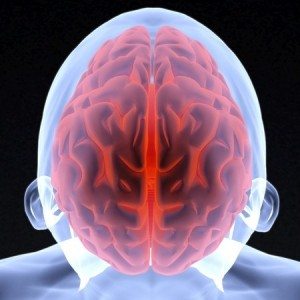 3.) Take Care of Your Brain
3.) Take Care of Your Brain
The gut acts as the “second brain” in the body. Physical trauma to the brain from violent sports, car accidents, or otherwise can have a dramatic effect on your bowel health.
As you learned, your brain is connected directly to the intestines by the vagus nerve. So while we talked about the importance of vagal health for digestion – I’m about to take the link even further to your energy, focus, and mood!
The vagus nerve also acts as a bi-directional highway for your neurotransmitters to travel between your brain and gut, & gut and brain. The majority of neurotransmitters are actually synthesized in the gut – and shuttled to the brain (and back) via this pathway.
Problems with the gut can cause problems with focus, anxiety, and depression. Likewise, problems with concentration, anxiety, & depression affect the gut!
The relationship is bottom-up as much as it is top-down – that means physical or chemical trauma to the nervous system will most certainly affect the gut.
Lion’s Mane mushroom may be a useful strategy for helping to heal the nerves in the brain & gut – including the main connector between the two – the vagus nerve.
I often include Lion’s Mane in gut protocols & recommend it to clients that have trouble focusing due to stress, mental fog, or who are looking to support the focus needed to maintain highly active lifestyles & careers. Lion’s mane works by helping to increase nerve growth factors.
While I don’t have proof, I personally feel it will help strengthen the nerve connections behind new habits, stress patterns, as well as physical muscle control & balance response to training. You carve new nerve paths and I feel that Lion’s Mane will help bolster & speed up the process of creating and strengthening those new nerve connections.
At the very least, we know it helps to heal damaged nerves from chemical or physical insult – and that, along with its cognitive benefits is enough evidence for me to take it.
I also support glutathione levels using liposomal glutathione, R-lipoic acid, or N-acetyl cysteine. These supplements help boost glutathione levels, recycle existing glutathione, and protect the nerves from toxins & oxidative stressors.
Don’t undervalue the role of stress, and the general health of the nervous system – especially when conditions have been chronic.
Of course, careful intake of sugar, alcohol, and medication will also promote brain and gut health.
Strategies to control blood sugar & stress also let the brain breathe & maintain its proper brainwave patterns for relaxation, focus, and sleep. I control elevations in blood sugar by taking 500mg of Berberine before meals.
Berberine increases your insulin sensitivity – so only works when sugar is high and will not drive you to hypoglycemia – a fantastic hack for your metabolic toolbox.
You can also train your brain to stay within specific brainwave patterns (neurofeedback) similar to the heart rate variability (biofeedback) meditation practice above.
Sometimes emotional or physical trauma will “shock” your brain and the brain will become stuck in a stress rhythm until it is coaxed back with brain training. The direct connection between the gut and brain will disturb the digestive rhythm as a result.
There are many focus apps and “binaural beats” apps that provide music or sound using these brainwave patterns – to help your body jump into focus, relaxation, or sleep more effectively. I am writing this while listening to Brain.fm. I’ve also worked with Braintime as a separate training technique.
There are neurofeedback centers scattered around the United States and they can provide more targeted brain training for you.
Disorders in rhythm can be behind some instances of anxiety, depression, insomnia, attention-deficit disorder & hyperactivity.
The longer you stay in certain rhythms, the more that the brain “learns” to stay in that rhythm. So you reverse the trend by actively training your brain in the opposite rhythms. This training (as well as HRV training explained above) will improve focus, relaxation, sleep, mood, & more.
See Simple Health Mind and Simple Health Books for more Dr. Rinehart Recommendations for brain and stress support that do not necessarily involve nutritional supplements.
4.) Digest Your Food in the First Place – Protect Your “Enzyme Reserve”
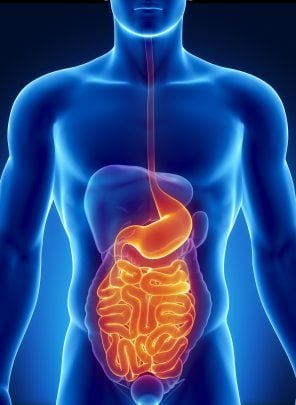 Digestion begins with the breakdown of food.
Digestion begins with the breakdown of food.
As we age, our ability to produce digestive enzymes decreases. It is called enzyme reserve.
Some argue that we have a limited ability to produce enzymes over our lifetime similar to how the heart has a relative limit to the number of times it can beat before it breaks down. It’s similar to a car engine that has a set amount of engine cycles before it breaks down.
The more stress you put on your enzyme reserve in your younger years, the more difficulty you may have in digestion later in life. Moreover, incomplete digestion triggers many digestive problems such as gas, bloating and slow motility.
Taking digestive enzymes is a proactive wellness practice to maintain this “enzyme reserve” and maintain potent digestion as you age.
My favorite companies for enzyme support include Enzymedica, and their professional subsidiary Enzyme Science.
As a professional line, Enzyme Science carries many of the same formulas as Enzymedica just at different names, but will offer more dosage at a better cost per dose.
I use Critical Digestion, Lypo Optimize, Betaine HCl, and Enzalase (by Master Supplements, Inc.) alone and in combination with each other.
For food intolerances, my most common choices are GlutenEase, Gluten/Dairy Digest, Gluten Manager, or Intolerance Complex.
For everyday digestion, I’ll also turn to Complete Digestion as a more affordable option to Critical Digestion.
Quick Summary of When to Use Each Enzyme:
Critical Digestion – is the strongest enzyme blend for all around digestion support. Complete Digestion is a less potent version that may also suffice for daily use. Compare these formulations to the very popular “Digest Gold” by Enzymedica & you’ll see what I mean about the great cost per dose with the professional formulations.
Betaine HCl – Turn to this when you need more help with protein digestion or suffer from hypochlorhydria (low stomach acid). Remember low stomach acid symptoms can present as high acid symptoms because the little bit of acid you produce is still splashed up to the esophagus as the stomach churns harder to digest food. The textbook way to dose is to keep increasing your intake until you feel a “warming” in your stomach and decrease a capsule from there. Over time, your need should decrease.
Zinc also helps support acid production (and taste perception). I like using Zinc Carnosine for its lining healing abilities, stress-balancing benefits, and its ability to support baseline zinc levels too.
Lypo Optimize – If you have trouble digesting fat, critical digestion may not be enough support on its own – so you can take Lypo Optimize on its own or in addition to a product like Critical Digestion.
Enzalase – Enzalase is unique in that it provides enzyme benefits deep in the digestive tract.
The capsules have a natural delayed-release mechanism where the capsule contents are delivered after the stomach. In contrast, other enzymes start working immediately at the level of the stomach & may be used up before assisting digesting in the later parts of the digestive tract.
If you find undigested food in the stool, experience bloating hours after eating – Enzalase can target partially digested food later on in digestion. In this way, Enzalase offers prebiotic benefits as it frees up byproducts from your food that support good bacteria in the gut.
I like using Enzalase in tandem with other enzymes to get the benefit of enzyme support in the stomach and deeper regions of digestion.
I use it especially when the primary symptoms are bloating 2-6 hours after eating – a sign of poorly digested food inviting bacteria overgrowth in earlier regions of the gut (see SIBO articles). Digesting your food more completely eases bloating at its source.
Moreover, Enzalase also contains a patented ingredient known as Enzastim that is believed to help “lubricate” the action of the enzymes. Master Supplements uses the same acid-proof delivery and Lactostim patents in Theralac, TruBifido, & TruFlora to support deep delivery & stimulation of probiotic growth without fear of the strains being killed by stomach acid. Due to its unique delivery, it’s difficult to compare Enzalase side by side to other formulations – I like taking it with Critical Digestion or Complete Digestion (mentioned above) so you get support at the level of the stomach AND later regions of the gut with Enzalase.
Wheat Rescue, Gluten/Dairy Digest, Gluten Manager & Intolerance Complex are used to support digestion of high-allergy, high-sensitivity, & high-intolerance food proteins when eating outside of the home or in shared cooking spaces.
Occasionally you may eat some dairy, grains, or excess legumes & starches in your diet, & these enzymes will help lessen the inflammatory impact of eating or being exposed to certain foods.
Even in the absence of an allergy or sensitivity – some food proteins such as grains and legumes are naturally tough on digestion & take more “enzyme reserve” to process than other foods.
Intolerance Complex & Critical Digestion are a nice combination catch-all for these types of food proteins.
Systemic Benefits of Enzymes
All enzymes promote systemic benefits when taken on an empty stomach (or when taken in excess of digestive needs).
When on an empty stomach, enzymes can be absorbed in the bloodstream where they can act on damaged proteins, or rogue immune cells. Also, there are wastes and byproducts produced from our daily metabolism and pathogenic microbes. When these build up they can make us tired, bloated, foggy-headed and more. Enzymes help digest these materials, supporting liver and immune health.
If you’re looking to take enzymes for these reasons – and believe that your bloating, constipation or general motility trouble is from these compounds – that is when you would turn to high protease products like Enzyme Defense Pro, Interfase Plus, or for Candida byproducts – Candida Control.
For cardiovascular cleansing, you can also turn to Nattokinase Pro – which helps breakdown clot-promoting proteins in the blood – it is also used to help thin mucous from chronic runny nose and sinus problems.
For muscle and joint repair purposes – a product like Myomend focuses on enzymes specific to the breakdown of scar tissue and wastes and inflammation from muscle tears. Most athletes and weekend warriors could benefit from Myomend to decrease excess inflammation & help them heal faster between workouts!
This is what makes enzymes fascinating. They not only promote digestion, but also have anti-aging benefits. You cannot overdose on enzymes either, although you’ll want to be mindful of the effects of an ingredient like Nattokinase if you’re taking blood thinners, or the chelating effect of the EDTA found in Interfase Plus if you have sluggish detox pathways.
5.) Promote the Neurotransmitter Acetylcholine
The vagus nerve sends its signals by using the messenger – acetylcholine.
Acetylcholine is a neurotransmitter. In the brain, acetylcholine promotes brain focus & alertness. In the gut – acetylcholine helps promote vagus nerve activity & motility. I find that gut & focus issues often come together.
Remember the vagus nerve acts as a physical two-way highway for neurotransmitters to channel back and forth between the brain and gut.
Here’s how to promote acetylcholine:
First, you can ensure adequate choline intake in the diet.
Choline:
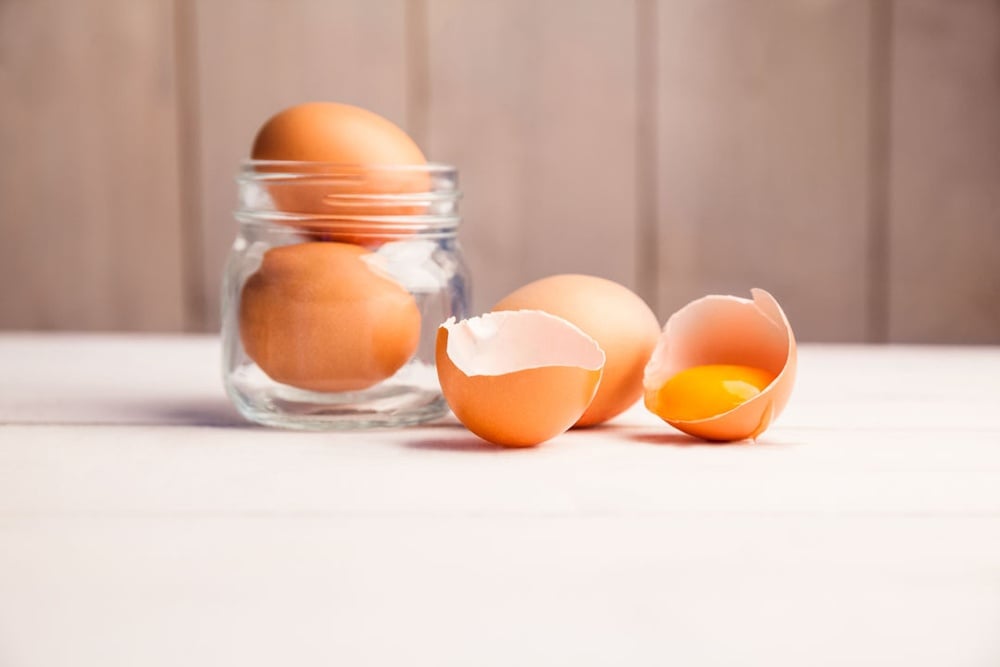 Choline is involved in detoxification, methylation, and nerve sheath development (myelination around the nerve). It’s also a raw material for acetylcholine production. All of these processes are essential for proper nerve health & neurotransmitter balance.
Choline is involved in detoxification, methylation, and nerve sheath development (myelination around the nerve). It’s also a raw material for acetylcholine production. All of these processes are essential for proper nerve health & neurotransmitter balance.
Choline is highly prevalent in egg yolks. I aim to eat two eggs a day to supply my daily intake of choline.
Some individuals are slow at producing choline in the body (or they may be allergic to eggs) – making choline an essential nutrient.
Those with choline issues may have gut motility issues as a result of genetic predilection or by dietary deficiency. Gene snps are slight variations in genes that differ between individuals (including twins). They may increase or decrease the activity of a gene.
Carriers of snps in the PEMT gene have trouble making their own phosphatidylcholine – so they are more dependent on dietary & supplemental sources of choline.
Without choline, detoxification, brain, and nervous system health can be altered.
You can supplement with choline by consuming both CDP Choline (which supports phosphatidylcholine past the blood brain barrier) and/or Phosphatidylcholine supplementation.
Supplementation with one or both of these may be essential if you’re not getting enough choline in the diet, or you carry the PEMT gene snp.
Many motility-oriented products will focus on acetylcholine precursors or boosters.
Acetyl-L-Carnitine
Acetyl-L-Carnitine is a precursor to acetylcholine.
It is the active form of “carnitine” that helps transport fat inside of cells for metabolism. It also provides the “acetyl” group necessary to make “acetyl”-choline. Some individuals cannot make acetyl-L-carnitine very well due to slight differences in their genetic makeup.
Acetyl-L-carnitine will not only promote acetylcholine production in these individuals – but it will also support fat metabolism too as it helps shuttle fat into the mitochondria to be broken down into energy.
For our purposes here, acetyl-L-carnitine, in the presence of ample supply of phosphatidylcholine & B-vitamins, provide the raw materials necessary to make acetylcholine in the body (as well as promote healthy fat metabolism).
Acetylcholine is a key neurotransmitter behind motility & can be supported with acetyl-L-carnitine, and phosphatidylcholine.
Ginger Extract:
Ginger root extract contains gingerols and shogaols that support acetylcholine and serotonin-like effects. It is found in MotilPro by Pure Encapsulations, and MegaGuard by Microbiome Labs
Huperzine A:
Huperzine A is an extract from club moss that acts as a natural acetylcholinesterase inhibitor. In plain English means that it prevents the breakdown of the acetylcholine that you produce in the brain (as well as the gut!). If you’re blocking the breakdown, then acetylcholine sticks around longer to perform its duties.
It is known mostly for a brain supplement, but there is some evidence (from a rat study) that it will support gut motility too (https://www.ncbi.nlm.nih.gov/pubmed/23403922). Because it’s mostly included in combination supplements for brain support – supplements that contain Huperzine A do not always make sense as a standalone motility support.
For motility purposes, Huperzine A by Progena has Huperzine A as its own standalone ingredient. I’m using it more in clients who have trouble tolerating the warming, burny nature of ginger extracts.
6.) Promote the Neurotransmitter Serotonin
Serotonin is also used by the gut to stimulate motility – another example of how the same neurotransmitters are shared by the brain & gut to perform different functions.
I made sure to start by talking about stress, the brain, the vagus nerve before getting into these specifics!
Medications such as serotonin-targeted antidepressants (SSRI’s) might lead to long-term issues with gut motility if someone was to become intolerant to the drug with long-term use.
How might SSRI use lead to motility problems?
SSRI’s work by flooding nerve spaces with serotonin. Usually the body “re-uptakes” serotonin from the spaces – SSRI’s block the process from happening.
With the flood of serotonin, the serotonin receptors get “tired” of the increased presence of serotonin, & they start to close their doors to the molecule. It’s like insulin resistance – but with serotonin.
Also, the body may start producing less serotonin receptors – since there is excess serotonin to go around. You essentially become serotonin resistant & the body responds as though it’s low on serotonin even if you are producing normal levels of serotonin in the first place.
When this happens – the role of serotonin in gut motility can also be diminished – making you more dependent on the action of acetylcholine. If the production of both neurotransmitters is off – risk for bowel slowing increases even more.
This is also why tapering off SSRI medications (or any psychotropic meds) is important. Your body needs time to build the receptors and adapt to normal (& not synthetically elevated) levels of neurotransmitters – a process that can take weeks & months.
If you’re not on SSRI’s, you can support serotonin naturally with supplements like St. John’s Wort or 5-HTP often alongsideVitamin B6 for those on certain medications that may not play well with St. John’s Wort.
In constipation profiles – St. John’s Wort would promote motility as opposed to slowing – so my inclination is that it has a dual effect of slowing high motility guts and speeding up low motility guts due to the bidirectional effects of serotonin on motility regulation.
St. John’s Wort separately contains serotonin-like molecules that naturally stimulate serotonin activity with arguably less side effects as its effects are naturally mediated, and not synthetic like a man-made drug. Interestingly, St. John’s Wort has also been used as an antimicrobial but that is beyond this discussion.
If you’re taking antidepressants, especially SSRI’s, avoid taking any products that may contain St. John’s Wort or 5-hydroxytryptophan (5-HTP). Be careful when using these supplements (or do so under supervision) as they are contraindicated with a number of medications.
5-HTP works with vitamin B-6 (pyridoxine, or pyridoxal-5-phosphate/P-5-P) to synthesize serotonin in the body.
Stress, medications, or genetics may deplete the body of B-6. The active form of B6 known as pyridoxal-5-phosphate (P-5-P) is preferred to replenish body levels and stores.
I combine P5P, with Pantothenic Acid (B5) and Vitamin C as foundational support stack for adrenal fatigue and stress.
I was very purposeful in listing “manage stress” as my top motility strategy – and some of the elements are reinforced in this discussion on serotonin, and again in the next section…
In section 8, I introduce MotilPro – a product that combines acetylcholine & serotonin support along with the digestive stimulation of ginger extract. Now you understand why it is one of the most utilized products by practitioners for supporting regularity – independent of probiotics and fiber.
7.) Caffeine Intake – Overworking Adenosine Receptors & Catecholamines
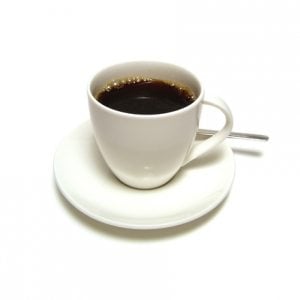 Caffeine from coffee and tea will stimulate adenosine receptors & catecholamines like adrenaline, norepinephrine, & dopamine. These neurotransmitters are “excitatory” by nature & work to encourage movement through the digestive tract.
Caffeine from coffee and tea will stimulate adenosine receptors & catecholamines like adrenaline, norepinephrine, & dopamine. These neurotransmitters are “excitatory” by nature & work to encourage movement through the digestive tract.
Remember, the sympathetic (fight or flight) nervous system controls the urge & control of final defecation. Anything that promotes the dumping of catecholamine hormones (like caffeine) will contribute to the incidence of bowel urgency, loose stools, or diarrhea.
One of the lesser talked about reasons that individuals love caffeine in the morning – is that it triggers a bowel movement.
Caffeine becomes part of morning routines that include wakefulness, focus, & the urge to have a bowel movement – it is easy to forget that caffeine is an addictive & excitatory substance that is stealing away from future energy and forcing your hormones to compensate daily.
Even if you’re a fast metabolizer of caffeine, you might be a slow metabolizer of catecholamines (adrenaline & noradrenaline) – and the chronic surges of adrenaline and noradrenaline can also lead to fatigue.
The specific set of genes is known as COMT for those who have had a genetic analysis performed – the more SnPs you have in COMT, the more sensitive you are to spikes in stress hormones. Most of the time, those with COMT actually have good focus and energy. These are people who can study and read for long periods of time. The problem is that they are often hit the wall hard and are vulnerable to burnout if they do not allow periods of recovery.
High doses of magnesium, vagal strengthening exercises, and general recovery & stress management are the best ways of dealing with COMT snps.
Even the most stubborn coffee drinkers who can have a cup of coffee at 11 pm and still fall asleep fine will report better sleep if they just kept their intake to the morning. If they still are stubborn that the caffeine is okay – sleep monitoring devices would show that they’re not getting an as high quality of sleep as they could (as measured by movement and length of time spent in deeper sleep cycles).
HRV monitoring as mentioned above would also show less optimal HRV with chronic caffeine consumption – be sure to consume it in cycles and use coffee replacements for at least 10-week periods. My favorite replacements are mushroom teas by Four Sigmatic.
I love coffee and tea as much as anyone – most of the local coffee shops know my order when I step up to the register – but I do rotate decaf coffee and take complete two-week breaks to allow my adenosine receptors to recover from the caffeine overstimulation & to prevent caffeine addiction or cyclical fatigue.
Sensitivity to mycotoxins in lesser quality coffees will also wreak havoc on your immune system & gut – so be mindful of coffee quality. Choose high-quality, single-estate beans (be more careful of coffee “blends” that combine beans from multiple estates or regions). If decaf- look for the Swiss-water method.
Activated charcoal & immunoglobulins (IgG) can help bind mycotoxins in those who’ve been exposed. When it comes to activated charcoal, overuse of activated charcoal can bind you up & steal nutrients from the body. If you use it, drink lots of water & identify the source of exposures so that you’re not dependent on taking it.
A quality local roaster can educate you on the more delicate details – and Bulletproof coffee (Dave Asprey’s brand) or Kion coffee (Ben Greenfield’s brand) have made entire brands around some of these topics.
8.) Ginger for Motility
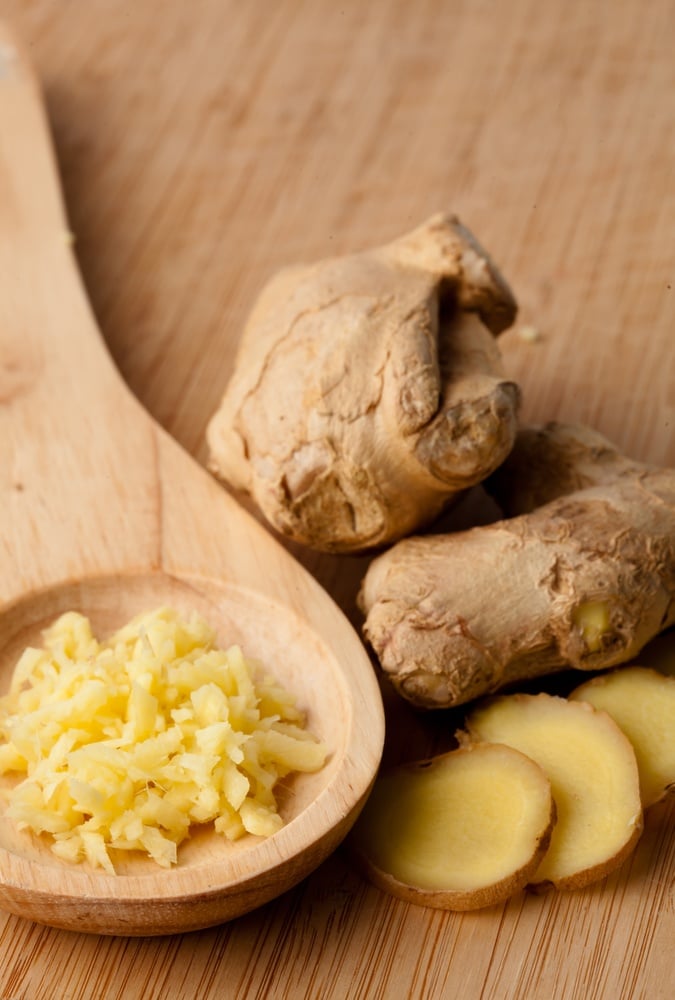 Ginger extract has metabolites that modulate both serotonin and acetylcholine receptors – helping to boost motility. It’s also anti-inflammatory & immune-modulating.
Ginger extract has metabolites that modulate both serotonin and acetylcholine receptors – helping to boost motility. It’s also anti-inflammatory & immune-modulating.
These combined mechanisms make ginger fantastic for supporting motility in the gut. Motility & regularity supplements often contain ginger for good reasons.
The drawback is that the extract can give you a warm, burning sensation that can be irritating to a sore stomach. Dose to tolerance when using ginger – and understand that the burning is not generally acid – but irritation from the warming nature of the active ginger compounds.
Supplemental ginger extract or making a tea out of the raw ginger can be helpful too.
At this point, you can understand why MotilPro by Pure Encapsulations is one of my favorite products.
It combines ginger extract, acetyl-l-carnitine, active b6, & 5-HTP – supporting the production of both acetylcholine & serotonin naturally. If you combine this with stress support and a break from caffeine -this alone can be a great reset for gut motility.
If the ginger is too strong or you have concerns of it irritating a sore gut – clients seem to tolerate Motility Activator by Integrative Therapeutics better while still enjoying the benefits of improved motility.
You might also support the gut lining so it is less irritated with mucosal support ingredients like those found in Glutagenics by Metagenics or MegaMucosa by Microbiome Labs.
MotilPro is still my first-line choice, yet I’m finding Motility Activator as the next best thing for clients sensitive to the potential warming/burning sensation created by MotilPro.
I also love Mega Guard by Microbiome Labs as it leverages the power of licorice flavonoids and artichoke leaf extract in addition to a high-potency ginger extract to support mucosal health and motility.
I’ve discussed the 7 core strategies for mucosal repair previously.
9.) Motility Concerns with Probiotics, Dysbiosis, & Small Intestinal Bowel Overgrowth (SIBO)
The gut is filled with trillions of bacteria – most of which reside in the large intestine. Dysbiosis is a term used when these bacteria are out of balance. Small Intestinal Bowel Overgrowth (SIBO) is a further example of “dysbiosis” when the overgrowth and imbalance is focused in the small intestine.
SIBO can be a result of normal small intestinal bacteria that have overgrown -OR it can also be from bacteria from the large intestine that migrated into the small intestine. One of the most overlooked aspects of SIBO treatment is promoting motility to prevent & minimize this migration. I’ve collected a number of articles on SIBO.
The best SIBO protocols also include motility support to prevent relapse!
When food is not moving through the gut efficiently – a few things can happen.
As we learned earlier, large intestine bacteria are responsible for fermenting food and breaking it down into useful metabolites and waste.
If this fermentation happens too early – it can cause significant bloating, distention and discomfort associated with SIBO. The small intestine is “small” in diameter – and there’s less space to tolerate the gas creation.
The ileocecal valve can switch between cycles of being stuck open or stuck closed. You can have bacteria unnaturally producing gas in the small intestine – and the ileocecal valve not opening or closing correctly – that’s a recipe for discomfort & problems with regularity!
Increasing intake of magnesium can promote healthy smooth muscle tone like that in the ileocecal valve. I like magnesium glycinate as the glycine residue of the combination is also supportive of relaxation. I usually have a tub of 360ct tablets in my pantry to support stress, detoxification and sleep (in addition to gut motility). It’s a supplement I take routinely.
Of course, MotilPro and the other strategies above are also helpful.
SIBO protocols generally begin with a killing or starving stage of these bacteria (even the friendly ones) – and a period of slow re-establishment of microbial diversity. If the gut material is still not moving properly – SIBO relapse is frustratingly common.
I will generally avoid Lactobacilli containing products – and stick with a Bifidobacteria blend to start such as Megasporebiotic & TruBifido. You still want to add other strains in time – just later on as SIBO is resolved.
I’ve discussed probiotic strategies in depth in my article on what probiotics to take during and after antibiotics.
It is one of my most popular articles on the site as it provides more detail on what order to take probiotics while healing the gut – navigating these steps is the top reason that clients choose to work with me one-on-one – yet I discuss most of my strategies in the link above for free.
10.) Inflammation or Infection
When the gut is inflamed or infected – it can also be hypersensitive and prone to states of constipation or diarrhea. The area becomes “protective” and may slow up all-together. Also, if you’re taking an antibiotic – you may drive flora imbalances that also affect motility detrimentally.
I love recommending Curcumin as a general catch-all for inflammation – and research supports a role for promoting nerve and gut integrity, as well as detoxification. It’s up there with Lion’s Mane when I feel I need extra support for the gut.
As for infection – monolaurin is my go-to source to support different types of overt and hidden overgrowth and infections. Monolaurin was first discovered in breastmilk, but is naturally derived from coconut oil in pellets or capsules. For my private clients, I use Inspired Nutrition for pellets, and, for capsules I use Natural Cure Labs.
Oregano oil, berberine, or a combination product like Biocidin are quite useful in the gut.
11.) Elemental Diet – the Reset Button for your Gut
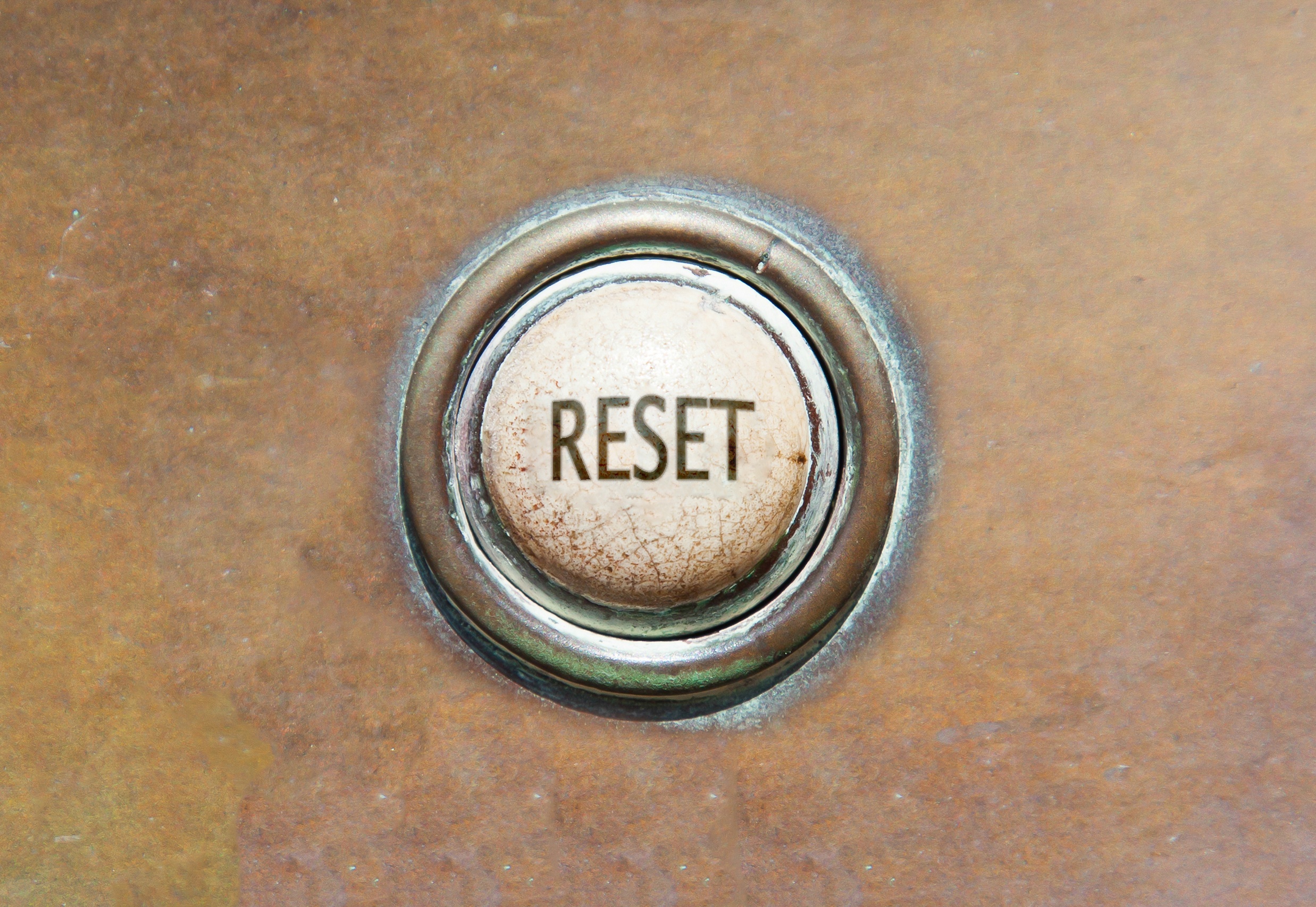 Elemental diets are a way to give the gut a much needed rest. It involves drinking a medical powder comprised of nutrients in their simplest, digestible state.
Elemental diets are a way to give the gut a much needed rest. It involves drinking a medical powder comprised of nutrients in their simplest, digestible state.
The powder requires no enzymes or gastric juices to be absorbed adequately in the gut. I personally use Integrative Therapeutics Physician’s Elemental Diet Powder – Dextrose Free when I recommend elemental diets.
Elemental diets can be used therapeutically for 14 days to treat SIBO naturally – and then the powders are tapered as a source of calories as normal food is reintroduced. They can also be used as a 1-5 day “gut reset” to give your digestive system a chance to heal and recover. Others may use them on a 50/50 calorie basis with normal food as another way to rest the gut.
Elemental diets have been well-regarded to stimulate motility in the gut & establish healthy nutrient absorption. I’ve discussed the elemental diet in detail previously.
12.) Intermittent Fasting (both bacteria growth and motility)
 Intermittent fasting & time-restricted feeding strategies are very popular topics right now.
Intermittent fasting & time-restricted feeding strategies are very popular topics right now.
When people think of circadian rhythms, they think primarily of sleep and wake cycles. Circadian rhythms affect biology much more than just sleep.
The gut also has a “sleep” and “wake” cycle to it. If you never give the gut a break – it starts confusing its cycles.
Intermittent fasting is a great strategy to allow the gut to recover. It has been shown to help boost motility & also promote the growth of diverse microbes in the gut as the body can really focus on full digestion of the food you eat.
I’ve discussed my Favorite Fasting Strategy in a previous article & detailed the benefits of fasting more directly.
More aggressive schedules like the Fasting Mimicking Diet – or full 24 hour fasts have their benefits too for full cell & tissue recovery, as well as optimization of immune benefits.
But for the sake of motility & promotion of gut microbes – intermittent fasting on a 16/8 or 14/10 cycles is an adequate strategy.
At the very least, aim to keep your feeding to just a 12-hour window per day! You’ll quickly realize that once you can do 12 hours, upping the game to 14 or 16 hours isn’t so bad – especially when your hunger hormones rebalance from the fasting.
13.) Magnesium for Improving Regularity
I mentioned magnesium briefly above when I mentioned supporting function of the ileocecal valve.
Magnesium is relaxing in nature – especially for smooth muscle. Taking magnesium can help relax tension in the bowels. Generally, dose magnesium until a bowel movement is triggered and then it back down.
Magnesium is essential to over 300 reactions in the body – it is commonly deficient in Americans due to our lack of intake of vegetables & chronic stress. Many medications also deplete the body of this vital mineral.
No wonder why so many Americans suffer from bowel irregularity!
Magnesium citrate works well for motility, but the citrate portion can be irritating to some individuals. I generally use Magnesium glycinate or malate to support magnesium levels in the body.
Most people are deficient in magnesium – so it can be an inexpensive way to get the bowels moving again.
Aside from supplementation, take this discussion as a friendly reminder to eat more leafy greens!
Note on Vitamin C:
Vitamin C is a less preferred way to trigger a bowel movement. When you take excess vitamin C, unabsorbed vitamin C finds its way to the gut.
When you have an extra concentration of something in the gut (high osmolality) – the body responds by diluting it with water. When you draw excess water into the colon – it creates loose stools, diarrhea, and a sudden urge to use the restroom.
Many substances trigger the same mechanism – so if you have loose stools, think about anything that your body may be trying to dilute & release from the system (including allergic/sensitive/intolerant foods)!
Vitamin C is often dosed up to the point where it triggers diarrhea (and then backed down a capsule to tolerance). Vitamin C has many other benefits, but I wouldn’t turn to it for gut motility support. Instead I turn to it for immune and stress support – only to the point where it is not disrupting bowel movements.
14.) Massage Therapy and Yoga – especially for Low-back and Hip Tightness
 Sometimes a massage or stretching is enough to relax muscle spasm and allow the bowels to rest. It is not uncommon to have the urge for a bowel movement moments into a massage, a walk, a light jog or other movements that relieve stiff muscles and promote relaxation.
Sometimes a massage or stretching is enough to relax muscle spasm and allow the bowels to rest. It is not uncommon to have the urge for a bowel movement moments into a massage, a walk, a light jog or other movements that relieve stiff muscles and promote relaxation.
Just changing positions – rolling on your sides, bridging or lifting your hips, or engaging in the child’s pose (typical to yoga) – may allow rising gas or gravity do the work for you. Body movement is important for brain & body function & relaxation.
Move your body consistently throughout the day – not just during a workout or stretching session.
A great hack for gut motility and keeping your blood sugar stable after a meal is to go for a 15-20 minute walk after eating.
Instead of turning to supplements, maybe you just need to move more!
15.) Ileocecal Valve dysfunction, Hernias, Physical Scarring or Obstruction
Appendicitis, short-bowel syndrome, lap-band procedures, gallstones, pancreatic cysts, diverticulitis, bowel impactions, hiatal hernias, esophageal strictures, tears/bleeds, & tumors can all affect motility in their various regions of the gut.
Procedures may leave sutures, surgical clips, or physical scar tissue that can impede the flow of material in the intestines. The same can go for natural blockages from inflamed, swollen, & infected areas.
Targeted circular massage to the belly in the direction of flow can also help to stimulate the bowels or help move gas along.
Targeted massage or pressure techniques for hiatal hernias & the ileocecal valve area exist – you can do this yourself once you learn how – but an alternative practitioner such as a naturopath, chiropractor, or applied kinesiologist receive training on these maneuvers.
You can find online guides as well. I avoid giving more exact instruction as it is something best demonstrated in person.
The areas are naturally tender when overworked – and so it is easier to relax when another person is doing the procedure for you. These practitioners can help better evaluate what’s going on in the first place too.
A regular relaxation or trigger point massage will often do the trick. You’d be surprised at how many clients “relax” and “release” a little too much after stretching, mobilizing, adjusting, or performing a myofascial release on them.
A great muscle relaxing strategy for gut motility is taking peppermint oil. Peppermint oil also relaxes muscle spasm. When the gut is tired, overworked, and irritated – it can become spastic both in tone and muscularity.
Peppermint oil helps relieve this by relaxing sphincters and easing food along the digestive tract. Optimizing motility with most of the strategies discussed in this article will help overcome physical hurdles or keep you functional as a long-term strategy despite unique circumstances to slowed GI transit.
16.) Natural Digestive Bitters & Proper Chewing –
Your grandmother may have emphasized the importance of chewing your food correctly. In fact one of the reasons many people eat unhealthy food is that it doesn’t take as much chewing as fibrous vegetables and leafy greens.
If you’re having motility issues, it’s time to get more serious about chewing.
Fennel, fenugreek, ginger and others can offer stimulation to the GI tract. Bitter herbs can be used in combination with digestive enzymes to promote wellness.
If I’m feeling a little bloated or am ready to take on a massive feast – I’ll chew on some fennel seeds from my spice cabinet before and after to aid digestion. You can steep them in hot water and make a homemade tea. Add some ginger, cinnamon and honey and you have a pleasant-tasting, & gut stimulating tea.
Peppermint Oil G.I. by Protocol for Life balance is an affordable mix of peppermint oil, ginger oil, and fennel oil to promote motility and relieve intestinal spasm.
The bitterness communicates to the gut that food is coming – and the organs better prepare to release juices. Chewing on these things directly, as well as supplementing with them can help stimulate healthy digestive flow.
Adding bitter greens like mustard, turnip & dandelion greens in meals can aid digestive flow – they’re just not popular dietary ingredients on the average dinner plate so the next best thing is to go to the spice cabinet or look to supplementation.
Many cultures have practices of aperitifs before dinner – these generally start stimulating the flows of digestive juices and ease digestion.
Chewing thoroughly also assists as the enzymes and muscles of the gut need to work that much less to process your food.
Mindful eating gives you a moment’s rest from the day – helps you avoid checking your phone or continuing to work while eating – and it gives you a natural moment to breathe & enjoy a nourishing meal with family or friends.
17.) Avoid High-Intensity Exercise Directly After Eating
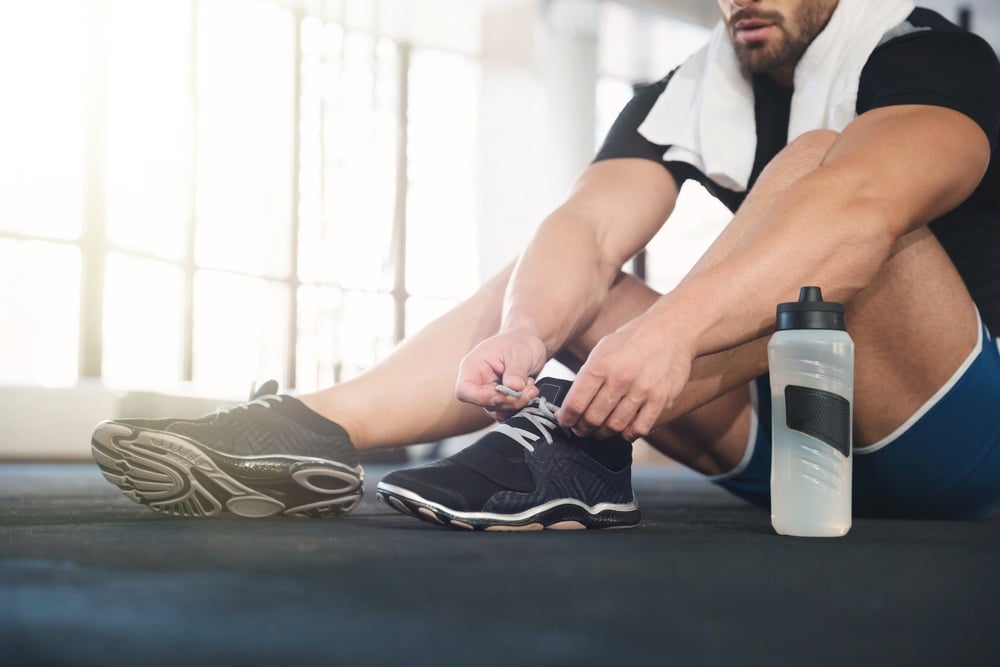 Exercise is stressful on the body over the short-term. When stressed, we are less adept at digesting our food. Eat a large meal 3-4 hours before any exercise of higher intensity.
Exercise is stressful on the body over the short-term. When stressed, we are less adept at digesting our food. Eat a large meal 3-4 hours before any exercise of higher intensity.
Keep food intake closer to 100-300 calories if you’re within a 2-hour window before higher-intensity exercise. You can save larger meals for post-workout recovery.
Interestingly, Zinc Carnosine supports your ability to recover from the stress of exercise due to its boosting of heat shock proteins.
As mentioned earlier, it is very beneficial to go for a 15-20 minute walk after eating. The gentle movement is relaxing, and the activity will help burn glucose from the meal more efficiently – so there are great digestive and metabolic benefits to walking after eating.
I like to do belly breathing while walking and sometimes listen to meditation or brain.fm and treat it as a nice mental break as well before I move on to the afternoon or evening tasks.
You are also upright when walking – meaning you have gravity assisting digestion too before you go back to lying down on the couch or sitting at a desk. Sitting or standing up prevents stomach acid from splashing on your esophagus & contributing to quiet reflux that can erode the esophagus over time – even in the absence of clinical reflux. Not eating in the 2-3 hours leading up to bedtime will optimize your digestive function.
If you do experience GERD, it is often a result of TOO LITTLE of stomach acid. The stomach churns harder and splashes the little acid you do have higher into the esophagus.
Betaine HCl supplements tend to help with reflux symptoms.
You need the acidity to digest various nutrients so long-term use of acid blockers may reduce these acid-dependent nutrients like iron, calcium, magnesium and more.
Occasionally you may need to calm the gut as betaine HCl may be too warming to start. Zinc carnosine, or botanicals like marshmallow root can help heal and soothe the lining so that you can tolerate higher intakes of Betaine HCl (as well as ginger-containing supplements).
18.) Let’s Talk about Fiber Baby!
Fiber comes in two forms. Soluble and insoluble. Soluble fibers are fermentable and are broken down by bacteria in the gut. The act as fuel for the trillions of microbes in the intestines, and the microbes give us useful metabolites in return like short chain fatty acid, B-vitamins, and vitamin K to name a few.
If soluble fiber creates problems for you with gas, bloating or distention – it’s indicative of dysbiosis or bacterial overgrowth in the gut. It means the bacteria responsible for breaking down soluble fiber are missing, overgrown, or out-of-balance.
Before turning to probiotic and prebiotic supplements, it is often necessary to reduce overgrowth and “clean the slate” with natural antimicrobials like Biocidin mentioned earlier.
It is a good rule of thumb to add probiotics (like Megasporebiotic) and prebiotics slowly so you can assess how your gut responds. Too much too soon can cause dramatic shifts of motility leading to diarrhea, constipation, or both. If this happens, back down and increase more slowly.
For fiber, I start with MegaPrebiotic and graduate clients to TruFiber and Biotagen.
Insoluble fibers add physical bulk to the fecal material and can allow roughage for efficient elimination of wastes – the roughage provides leverage for the muscular gyrations to push the food through.
The trouble with insoluble fiber is that it can get too bulky – and your intestines can lose tone over time as it gets used to the extra help. So make sure you drink a lot of water if you use these supplements – they only work with adequate hydration. Without water – the fibrous material can sit in the gut like a rock.
Instead, I use them short-term while I also work to identify sources of inflammation or infection, re-establish diversity of microbes, improve the integrity of the mucosa & feed healthy microbes with supplementary or dietary prebiotics when the time is right.
Now you know what it takes to promote normal bowel regularity in the gut!
I’ve collected a resource page of most of the products mentioned in this article for easier browsing.


